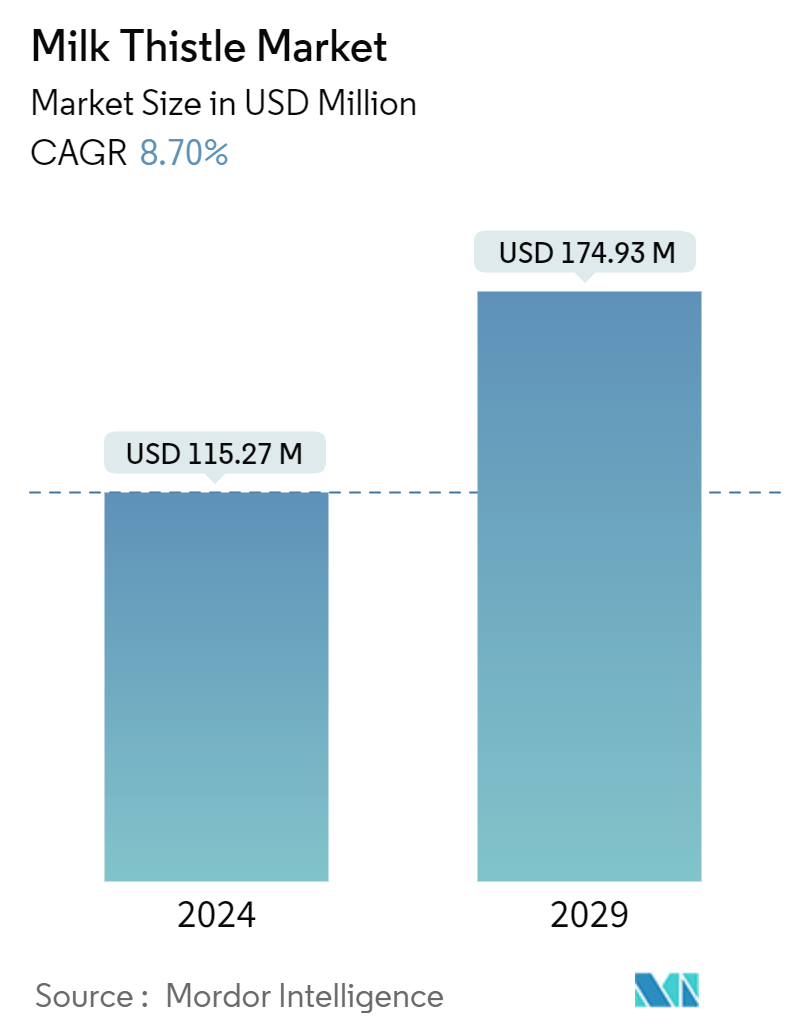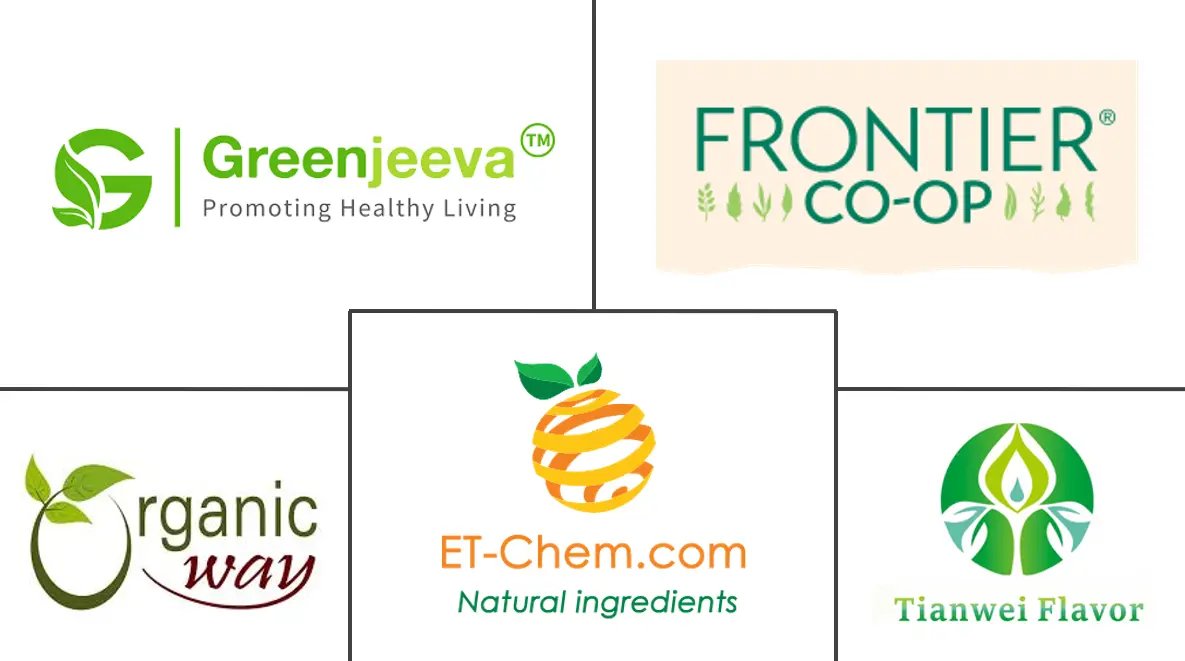Market Size of Milk Thistle Industry

| Study Period | 2019 - 2029 |
| Market Size (2024) | USD 115.27 Million |
| Market Size (2029) | USD 174.93 Million |
| CAGR (2024 - 2029) | 8.70 % |
| Fastest Growing Market | Europe |
| Largest Market | Asia Pacific |
Major Players
*Disclaimer: Major Players sorted in no particular order |
Milk Thistle Market Analysis
The Milk Thistle Market size is estimated at USD 115.27 million in 2024, and is expected to reach USD 174.93 million by 2029, growing at a CAGR of 8.70% during the forecast period (2024-2029).
The global market for milk thistle is on the rise, driven by its benefits in treating liver and biliary disorders. Its key component, silymarin, is renowned for shielding liver and kidney cells from drug-induced harm, notably from chemotherapy. Milk thistle has shown promise in lowering liver enzyme levels and exhibiting anti-inflammatory properties, along with modulating T cells. Preclinical studies underscore milk thistle's hepatoprotective and anticarcinogenic properties, including its ability to impede cancer cell growth in various human cell lines, such as those from the prostate, skin, breast, and cervix. Moreover, the supplement is widely regarded as safe and well-tolerated, with minimal side effects—primarily gastrointestinal discomfort and mild laxative effects—making it increasingly popular among health-conscious consumers.
Milk thistle's rising incorporation in anti-aging skincare products is driven by its numerous benefits. The primary compound in milk thistle, silymarin, offers significant antioxidant and anti-inflammatory properties, which are crucial for addressing signs of aging. These antioxidants protect skin cells from oxidative stress caused by environmental factors such as UV radiation and pollution, which can result in photoaging, fine lines, and wrinkles. Thus, cosmetics manufacturers are increasingly incorporating milk thistle in their products. For instance, Paula's Choice incorporates milk thistle into its cosmetics, asserting its skin benefits, including anti-aging properties, dark spot reduction, and promoting an even skin tone.
Moreover, Asia-Pacific dominates the milk thistle market, buoyed by its rich heritage in herbal medicine and a rising embrace of Ayurvedic practices. The region's growing awareness, especially in developing nations, of milk thistle's benefits, coupled with a surging demand for Ayurvedic tea variants, propels market expansion. Factors such as a heightened focus on liver well-being, rising incomes, a robust presence of industry leaders, and supportive regulations collectively fortify Asia-Pacific's leading stance in the global milk thistle landscape.
Milk Thistle Industry Segmentation
Milk thistle, also known as silymarin, is a botanical plant that belongs to the daisy and ragweed family. The plant is known for its antioxidant properties, which are primarily derived from the seeds of the milk thistle plant. The global milk thistle market is segmented by form, application, distribution channel, and geography. By form, the market is segmented into extract, powder, and whole. By application, the market is segmented into dietary supplements, food and beverage, and cosmetics. By distribution, the market is segmented into retail and industrial. By geography, the market is segmented into North America, Europe, Asia-Pacific, and Rest of the World. The market sizing has been provided in value terms (USD) for all the abovementioned segments.
Milk Thistle Market Size Summary
The milk thistle market is experiencing significant growth, driven by its extensive health benefits, particularly in liver health and its role as a dietary supplement. The key component, silymarin, is recognized for its protective effects on liver and kidney cells, making it a popular choice for those seeking natural remedies for liver disorders and detoxification. The market is further bolstered by the increasing consumer preference for natural and herbal products, as well as the rising awareness of milk thistle's potential in managing conditions such as diabetes and neuroprotection. The demand for milk thistle is also rising in the cosmetics industry, where its antioxidant and anti-inflammatory properties are valued for their anti-aging benefits. This trend is particularly evident in regions with strong herbal medicine traditions, such as Asia-Pacific and Europe, where the incorporation of milk thistle in dietary supplements and skincare products is becoming more prevalent.
The European market for milk thistle is expanding due to the high prevalence of chronic liver diseases and the growing interest in natural health solutions. The herb's liver detoxification benefits and its role in supporting liver function make it a sought-after supplement for conditions like fatty liver disease and hepatitis. The market is characterized by the presence of key players who leverage their geographical reach and brand awareness to maintain a competitive edge. These companies are focusing on product innovation and certification to enhance consumer trust and expand their global presence. The adoption of Ayurvedic and traditional herbal practices in Europe further fuels the demand for milk thistle, as consumers increasingly seek holistic health solutions.
Milk Thistle Market Size - Table of Contents
-
1. MARKET DYNAMICS
-
1.1 Market Drivers
-
1.1.1 Heightened Interest in Functional and Nutritious Foods Driving Demand
-
1.1.2 Rising Concerns Over Liver-related Diseases
-
-
1.2 Market Restraints
-
1.2.1 Potential Adverse Effects of Milk Thistle
-
-
1.3 Porter's Five Forces Analysis
-
1.3.1 Threat of New Entrants
-
1.3.2 Bargaining Power of Buyers/Consumers
-
1.3.3 Bargaining Power of Suppliers
-
1.3.4 Threat of Substitute Products
-
1.3.5 Intensity of Competitive Rivalry
-
-
-
2. MARKET SEGMENTATION
-
2.1 Form
-
2.1.1 Extract
-
2.1.2 Powder
-
2.1.3 Whole
-
-
2.2 Application
-
2.2.1 Dietary Supplement
-
2.2.2 Food and Beverage
-
2.2.3 Cosmetics
-
-
2.3 Distribution Channel
-
2.3.1 Retail
-
2.3.2 Industrial
-
-
2.4 Geography
-
2.4.1 North America
-
2.4.2 Europe
-
2.4.3 Asia-Pacific
-
2.4.4 Rest of the World
-
-
Milk Thistle Market Size FAQs
How big is the Milk Thistle Market?
The Milk Thistle Market size is expected to reach USD 115.27 million in 2024 and grow at a CAGR of 8.70% to reach USD 174.93 million by 2029.
What is the current Milk Thistle Market size?
In 2024, the Milk Thistle Market size is expected to reach USD 115.27 million.

